- Making an Impact: AIAA Student Design/Build/Fly Competition
- 2019 AIAA Regional Student Conferences
- Wang Presented Hampton Roads Section Inaugural Laurence D. Leavitt Lecture
- IAC Kickoff Reception Held on Capitol Hill
- AIAA Utah Section Supports Local Robotics Team
- First Dr. Hassan A. Hassan Graduate Awards in Aerospace Engineering
- AIAA Fellow Madelung Died in December 2018
- AIAA Associate Fellow Haloulakos Died in January 2019
- AIAA Fellow Hakkinen Died in March 2019
Bulletin
AIAA Foundation Making an Impact: AIAA Student Design/Build/Fly Competition
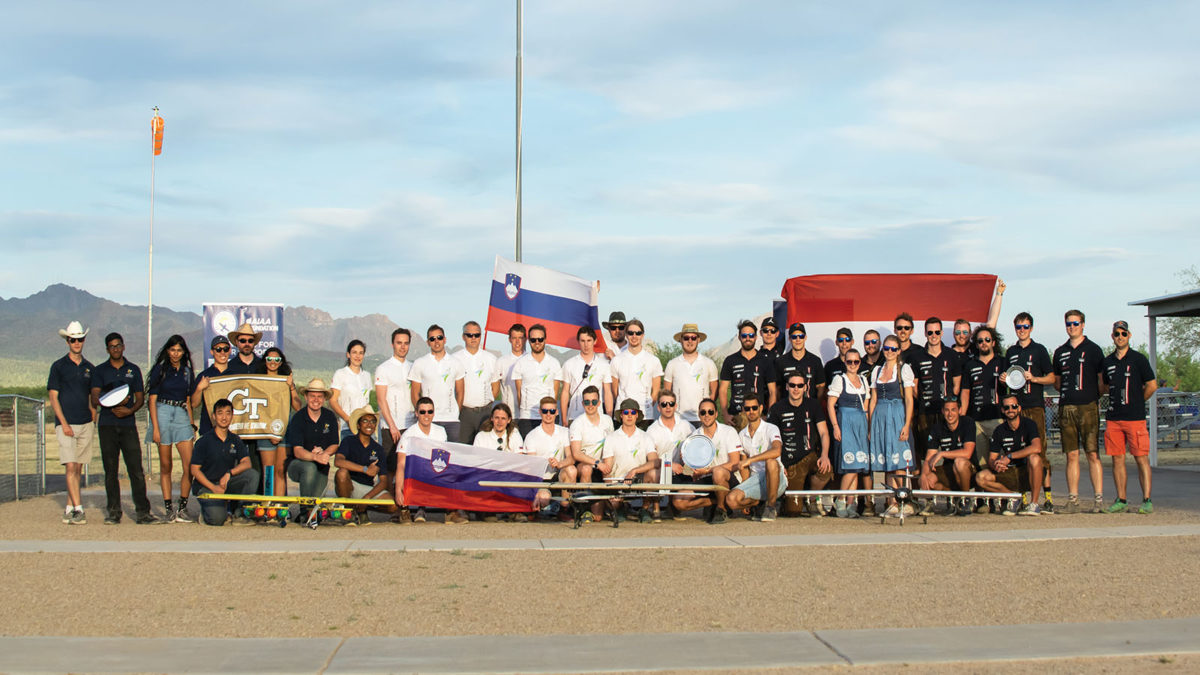
AIAA’s Design/Build/Fly (DBF) Competition encourages excellence in aerospace engineering skills at the undergraduate and graduate levels by challenging teams to design and fabricate a radio-controlled aircraft, submit a written report about the aircraft’s design, and fly their aircraft over a defined course while carrying a payload and landing it without damage.
In April, at the 23rd annual DBF, 77 teams comprising 785 students had designed a multi-purpose aircraft to support carrier operations. Ninety-six flights took place at the Tucson International Modelplex Park Association (TIMPA) Airfield and the team representing Slovenia’s University of Ljubljana won the event. The other top scoring teams were from Georgia Tech and Austria’s FH Joanneum of Applied Sciences.
Thank you to our sponsors: Primary: Raytheon and Textron Aviation; Gold: Lockheed Martin, AeroVironment, Aurora Flight Sciences, General Atomics and MathWorks; Silver: Honeywell; and Bronze: FlightStream. Get involved at next year’s DBF in April 2020 in Wichita, KS!
The AIAA Foundation supports DBF in an effort to advance aerospace and to ensure the next generation of aerospace professionals is equipped as they prepare to enter the workforce. More information on DBF can be found at aiaa.org/dbf. For information on how your organization can engage with and sponsor this event, please contact merries@aiaa.org.
AIAA Foundation 2019 AIAA Regional Student Conferences

AIAA sponsors student conferences in each AIAA region for student members at both the undergraduate and graduate levels. Students are judged on technical content and clarity of communication by professional members from industry. The conferences provide a venue for students to share AIAA experiences, participate in social activities, connect with industry professionals, and exchange ideas about current topics in aerospace engineering. Since 2018, Lockheed Martin Corporation’s generous donation to the AIAA Foundation has supported the Regional Student Conferences and the International Student Conference.
The first-place winners in each category are invited to present their papers at the AIAA Foundation International Student Conference held in conjunction with the 2020 AIAA SciTech Forum in Orlando, Florida, 6–10 January.
Undergraduate Category Winners
Region I: Volumetric Origami-based Deployable Modular Space Structures with Tailorable Stiffness, James H. Lynch and Jordan R. Raney, University of Pennsylvania
Region II: Airfoil Lift Calculation Using Wind Tunnel Wall Pressures, Sreevishnu Oruganti and Shreyas Narsipur, North Carolina State University
Region III: Active Flow Control in a Compact High-Speed Inlet/Diffuser Model, Collin O’Neill, Ohio State University
Region IV: Thermodynamic Calculations of Boiling Liquid Expanding Vapor Explosions (BLEVE), Joshua R. McElrath and Adonios N. Karpetis, Texas A&M University
Region V: Aerodynamic Analysis and Simulation of Degraded Flight Configurations of the A-10 Thunderbolt II, Reese Fairchild, Matthew Green, and Thomas R. Yechout, United States Air Force Academy
Region VI: Effects of Electric Field on Primary Electron Trajectories in Miniature Gridded Ion Thrusters, Juan-Pablo Almanza-Soto, University of California, Los Angeles
Masters Category Winners
Region I: Trim Analysis for an Electric Rotorcraft Utilizing a Moving Mass Control Scheme,Robert Brown, University of Maryland
Region II: Design and Testing of a Fault-tolerant Space Suit, J. Sublett, Georgia Institute of Technology
Region III: Lagrangian Coherent Structures in Optimal Vortex Ring Formation, Braxton N. Harter and James W. Gregory, Ohio State University
Region IV: Spectral Proper Orthogonal Decomposition Analysis of Shock-Wave/Boundary-Layer Interactions, Stephanie M. Cottier and Christopher S. Combs, University of Texas at San Antonio
Region V: Simulating a Vortex-Driven Cloud Feature on Uranus, Kevin Farmer, Saint Louis University
Region VI: Band Gap Optimization of Topological Waveguides, Tim Gormley, University of Washington
Team Category Winners
Region I: Design and Intergration of a High-Powered Model Rocket – I, Kyle F. Foster, Peter D. Dohn, Colin Y. Cooper, Amanda Dings, Jacob H. Fennick, Eve M. George, Nicholas J. Lapierre, and Ty F. Moquin, Worcester Polytechnic Institute
Region II: Implementation and Verification of a Versatile GN&C and Flight Software Architecture for an Active Control Launch System, Kunal S. Gangolli, Athreya Gundamraj, Wyatt Hoppa, and Shrivathsav Seshan, Georgia Institute of Technology
Region III: Specialized Terrestrial Rotorcraft Explorer, T. Hutchinson, N. Marquand, J. Springer, T. Swedes, S. Tandon, and J. Zyck, Purdue University
Region IV: N/A
Region V: Automatic Detection of Auroral Substorms from a CubeSat Platform Using Machine Learning, Valerie Lesser, Christopher Peercy, Vishranth Siva, and Colin Sullivan, University of Colorado Boulder
Region VI: Construction of Facility for Rotating Detonation Engine Research, Chinmay S. Upadhye, Andrew C. Jacob, Andrew J. Milligan, and Kevin Chau, University of Washington
Please visit the AIAA Regional Student Conferences website for more information (aiaa.org/home/get-involved/students-educators/student-conferences).
Section News Wang Presented Hampton Roads Section Inaugural Laurence D. Leavitt Lecture
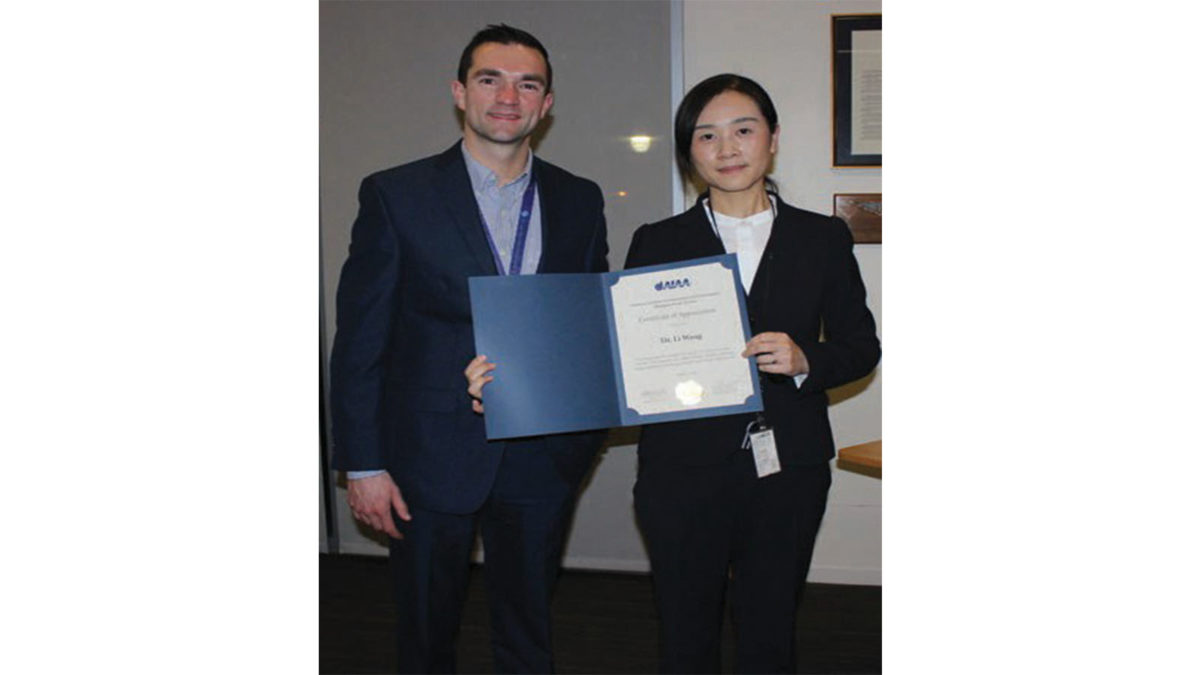
AIAA Hampton Roads Section (HRS) 2019 Engineer of the Year, Dr. Li Wang, presented the HRS Inaugural Laurence D. Leavitt Lecture on 7 March, at NASA Langley. Dr. Wang is a Senior Research Engineer at the National Institute of Aerospace (NIA) and physically works at the Computational AeroSciences Branch at NASA Langley. Dr. Wang has been leading research on the development of a practical and efficient design optimization tool for rotorcraft aeromechanics. She has created an integrated methodology to couple state-of-art computational fluid dynamics and comprehensive rotorcraft analysis, and to enable multidisciplinary sensitivity analysis for high-fidelity design optimization. Dr. Wang presented an overview of the multidisciplinary analysis and design optimization framework applied to rotorcraft applications. Prior to the lecture, Bobby Berrier presented a special tribute to Laurence D. Leavitt, for whom this annual lecture will be named henceforth.
AIAA Program IAC Kickoff Reception Held on Capitol Hill
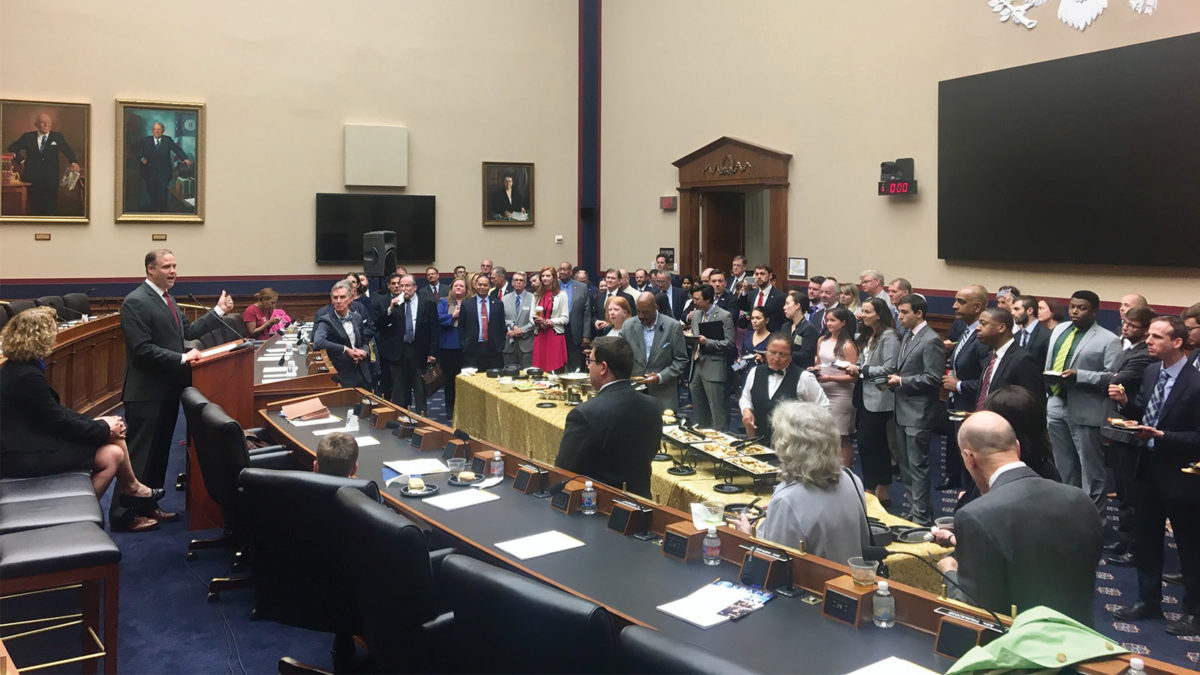
AIAA, in collaboration with eight sister societies, sponsored a congressional reception on 30 April for the 70th International Astronautical Congress (IAC 2019), which will be held 21–25 October in Washington, DC.
The reception, which included NASA Administrator Jim Bridenstine and Congressman Brian Babin (R-TX), House Aerospace Caucus co-chair and Ranking Member of the House Space and Aeronautics Subcommittee, allowed lawmakers and their staff to hear more about upcoming IAC 2019 programming being developed for them, including additional Hill briefings that will take place in the next few months.
Section News AIAA Utah Section Supports Local Robotics Team

The Intergalactic Bionic Porcupines First Lego League (FLL) robotics team received the Utah State Champion’s recognition and is going to the FIRST World Robotics Festival in Houston this April to represent the state of Utah and as one of the representatives of the United States. FLL is for kids ages 9-14 and teaches them STEM activities such as building and programming a robot and presenting original project research. Over 270 teams participate in FLL in Utah and 32,000 across the world.
This year’s FLL theme was improving long duration spaceflight. The robot game missions imitated space-related activities such as asteroid deflection, rescuing an astronaut, and crossing a simulated Mars crater. The team builds their autonomous robot using the EV3 Lego processor, which is programmed in a version of LabView. The EV3 Lego processor drives attachments of Lego Technic parts built by the kids to perform the robot game missions. In researching their project, the team met with astronauts, attended the Small Sat Conference at Utah State University, and spoke with NASA experts. The team prepared original research for their project by making and testing bricks and tools from simulated Mars soil (provided by University of Central Florida). Working with the University of Utah and Salt Lake Community College, the team manufactured and evaluated the strength of bricks and tools made from Mars simulated soil using 3D printing technology and various binders.
The team is sponsored by the AIAA Utah Section and is excited to be the FLL team representing Utah at the 2019 World Festival, which takes place in April. To achieve this distinction, the team had a best-in-state score of 283 out of 400 points in the robot game, displayed an innovative robot design concept, and were recognized for an outstanding project at the Southern Utah Championship on 16 February 2019.
First Dr. Hassan A. Hassan Graduate Awards in Aerospace Engineering
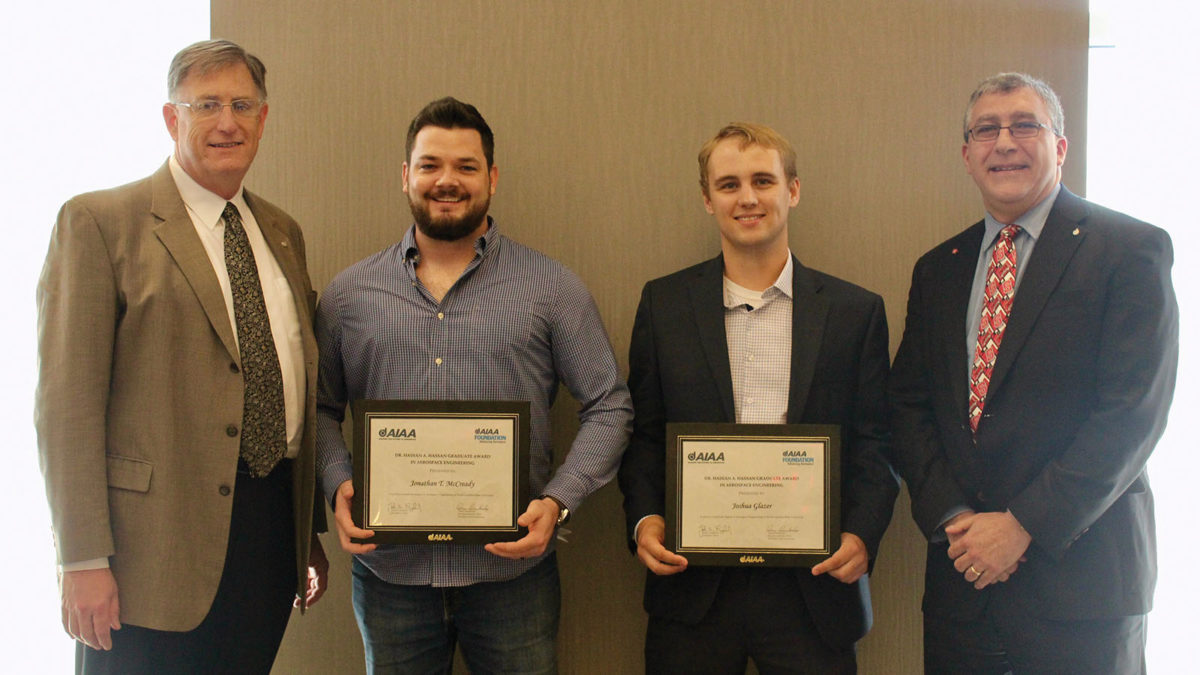
In May the AIAA Foundation presented the first Dr. Hassan A. Hassan Graduate Awards in Aerospace Engineering to Jonathan T. McCready and Joshua Glazer. The $5,000 Hassan Graduate Award is designed to entice top North Carolina State University (NCSU) aerospace engineering seniors, who also are AIAA members, to earn their graduate degree (M.S. or Ph.D.) in aerospace engineering at NCSU. More information about the award can be found at: aiaa.org/home/get-involved/honors-awards/awards/student-awards.
Obituaries AIAA Fellow Madelung Died in December 2018
Professor Gero Madelung, Honorary President of the RAeS Munich Branch e.V., died on 13 December 2018, aged 90.
Madelung studied aeronautics at the technical university in Stuttgart and Clarkson College. Under his uncle Willy Messerschmitt’s supervision, Madelung began his career as an aeronautical engineer and project manager for the HA200 at Messerschmitt AG, Entwicklungsring Süd (EWR) in Spain and later in Egypt on the HA300.
He worked in the United States for GEC and later was appointed Chief Technical Officer at Messerschmitt AG, contributing to the creation of MBB through the merger of the companies Bölkow, Blohm and Messerschmitt. He continued his practical aeronautical activities as the project leader of the VJ101 VTOL project. He was the first Managing Director of Panavia GmbH, having significant influence on the development of the Tornado multi-national aircraft program. He later returned to MBB as President and Chief Executive.
At the end of his industrial career he transferred his knowledge and experience in aeronautics to academia, becoming the inaugural professor at the Institute of Aircraft Design at the Technical University Munich. He was chairman of the “Messerschmitt Stiftung,” a foundation which supports the conservation of cultural assets and monuments. Under his leadership, and in cooperation with EADS (later Airbus), he encouraged the founding of the Messerschmitt Flying Museum, housing airworthy Messerschmitt aircraft at Manching.
Madelung was made an Honorary Fellow of the Royal Aeronautical Society in recognition of his many contributions to international aeronautics and supported the society as a member of the Medals and Awards International Adjudication Panel. He was a founding member of the RAeS Munich Branch in 1991, when Munich became a center of aerospace excellence in Germany with companies such as MBB/DASA and MTU together with the multinational agencies Panavia, NAMMA/NETMA, Eurofighter, Eurojet and Eurocopter. This international environment attracted staff from the UK, the European partner companies, and elsewhere to work in the heart of Bavaria. The branch, under his leadership and with active support from the new committee and membership, became a focus for encouraging friendship and networking within the aerospace and academic communities. With his active support it also became a German-registered “gemeinnütziger Verein,” which is an official German registered nonprofit charity organization.
In addition to these countless demanding professional and volunteer positions and activities he was an active glider pilot, still flying far into old age.
Madelung was awarded the highest honors in aeronautics from Germany and also internationally. An AIAA Fellow, he also gave the Wright Brothers Lecture in Aeronautics in 1977, entitled Characteristics of Fighter Aircraft.
Obituaries AIAA Associate Fellow Haloulakos Died in January 2019
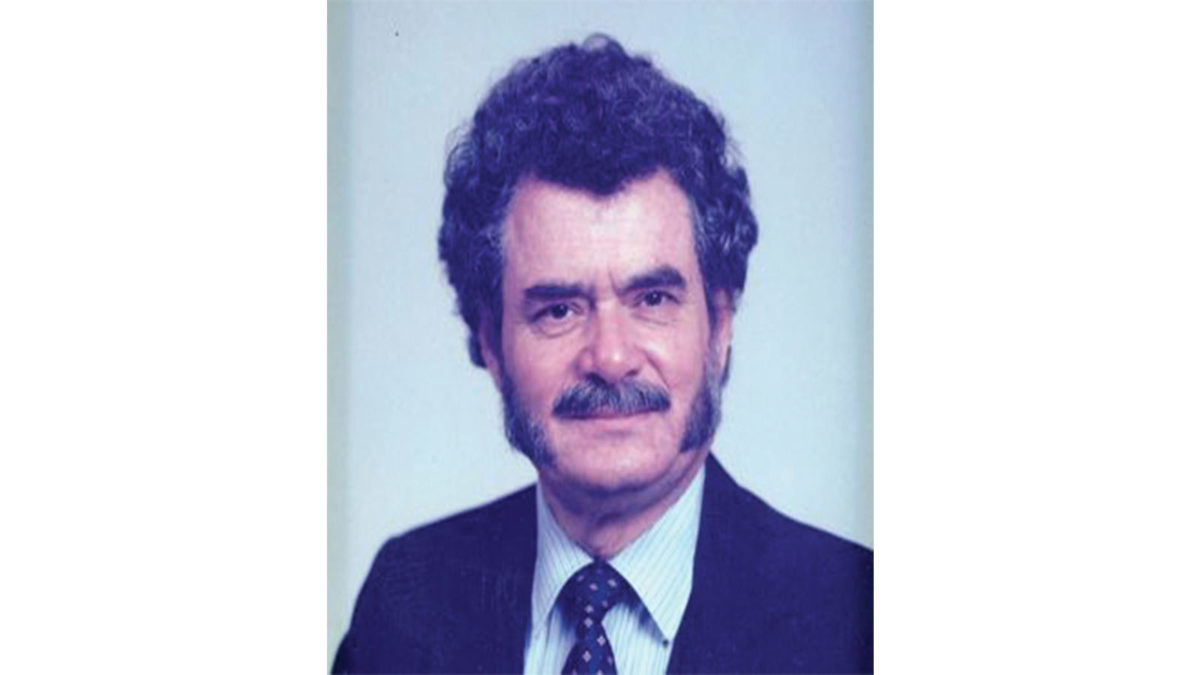
Dr. Vassilios Elias “Bill” Haloulakos died on 13 January. He was 88 years old.
Born in Sparta, Greece, he came to the United States as a member of the Greek Air Force Academy training at Lackland Air Force Base. There he met his wife (Victoria Villarreal Haloulakos), a civil servant with the U.S. Air Force, and later he became a U.S. citizen. He received his Bachelor’s (BSME), Master’s (MSAE) and Doctorate (ENGR.D) degrees from the University of Southern California’s Viterbi School of Engineering. He was studying for his master’s in 1962 along with Neil Armstrong before Armstrong was chosen for the astronaut program.
As a rocket scientist, aerospace engineer, and university lecturer Haloulakos was a major player/significant contributor in a golden era of aeronautics and aviation—the Jet Age, Space Race, and Cold War—with a stellar career from the late 1950s through the late 1990s at McDonnell Douglas Space Systems Company, Huntington Beach, CA. He worked with U.S. astronauts and on a couple of occasions with Soviet cosmonauts. Among the projects Haloulakos is associated with are the Gemini and Apollo manned space missions, Sky Lab, Upstage anti-ballistic missile interceptor, DC-10 jet airliner, NERVA (Nuclear Engine Rocket Vehicle Application), and the DC-X Clipper reusable single stage rocket.
Haloulakos served as president of various technical societies throughout the 1970s and 1980s, and was the author of two books (Mathematics, The Layman and Daily Life and Rocket Propulsion Fundamentals and Mission Analysis). In addition he published over 100 scientific & technical papers in his field, and his research has now been donated to Brigham Young University. His teaching career included university instructor in physics & mathematics, academic decathlon advisor, and as a docent at the Gene Autry Museum of Western Heritage. He viewed himself as a lifetime learner who stayed young by learning something new each day.




